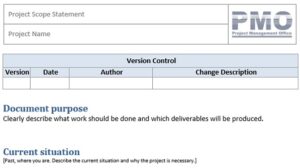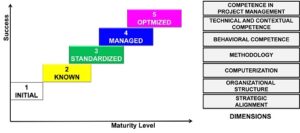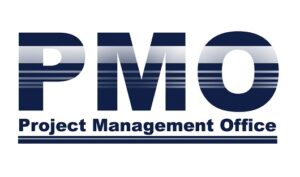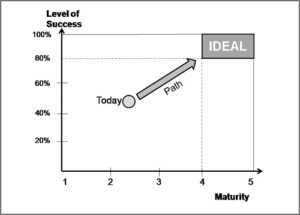Maturity in Project Management Series[1]
By Russell D. Archibald & Darci Prado
This is the second of a series of articles on PPPMM.
The Importance of Knowing Your Project, Program, and Portfolio Management Maturity: PPPMM
The world today depends on projects: almost a third of the world economy is generated through projects [1]. For many organizations, projects ensure their future and allow them to survive and grow. Projects can be seen in the construction of a new factory to launch a new product, the restructuring of a recently acquired company, the development and implementation of a computerized application, and achievement of many other strategic objectives. A thorough analysis of the world scene shows that failures to plan and execute projects properly have serious negative impacts on business results. For example, a study by the Standish Group [2], which has analyzed the efficiency of management of software projects in the U.S. since 1994, shows that the project success rate today in this area is still very low: 37%.
|
“In every kind of organization – governmental, institutional and industrial – there is a growing recognition that, although there are many projects within the organization, they are often poorly understood and inadequately managed” – Archibald [3] |
The world is becoming globalized and we are living in an era of great change, and the execution of complex and large projects has become common. For a growing number of organizations, the challenge is how to manage their projects and programs successfully. But ultimately, what is success? Certainly, the concept of project success is naturally understood in each department of organizations where the subject is practiced. However, conceptualizing success in project management, in a generic form that can be widely accepted, is not easy because this science has been applied in various human activities and traits that create significant differences. The following statement is not intended to be theoretically accurate in every respect and with comprehensive application without question, but is suitable for the purposes of this introductory text:
|
A successful project is one that hits the target. |
Project/Program/Portfolio Management Maturity
The concept of maturity is quite intuitive and has applications in many aspects of our day-to-day lives. In the case of project management, maturity is linked to how well an organization is able to manage their projects. The issue came into vogue rather recently, but it already occupies a prominent place: numerous articles have appeared in journals, lectures are given covering the subject, and graduate students choose the theme for their completion of course work or master´s thesis. After all, why so much interest in the topic? Of course it is inherent in the fact that organizations and processes evolve and mature, and that there is an intuitive relationship between maturity and success. In the case of Project Management (PM), several research studies [5,6,7,8] made in recent years have shown that maturity and success really go together. Figure 1 shows the results of these studies [3] for projects in the category New Product Development.
Certainly the curve in Figure 1 has different formats for different categories of project, as we shall show in other articles of this series and in the site www.maturityresearch.com. The categories that are usually considered when measuring maturity in their management are (Archibald, pp 35-36 [3]):
- Projects for Defense, Security and Aerospace
- Projects for Improvements of Productivity or Quality for obtaining better operating results; Organizational Changes Projects.
- Communication Systems Projects (Voice, data and image)
- Event Projects
- Engineering Design Projects, Architecture Projects, etc.
- Projects Ventures, Investments, Buildings and Facilities Constructions
- Information Systems Projects (software)
- Regional and International Development Projects
- Media & Entertainment Projects
- New Product or Service Development Projects
- Research and Development Projects

Figure 1. Levels of Maturity and Project Success.
Figure 1 shows, for example, that organizations at Level 1 have a success rate of 60%, or 60% of its new product launches are successful. Another interpretation for the same graph is that if an organization is at level 4, there is an expectation that their level of success is 80%. This matter will be raised below in the section titled Maturity and Success, but for now we can say that, for other categories of projects, Figure 1 acquires different formats. We can also add that the different curves for different categories of projects have the following features in common:
- As level 5 is reached, the success rate approaches 100%;
- As level 4 is reached, the success rate is around 80%.
We believe that these statements are valid regardless of the specific maturity model that has been used to determine the maturity level of a given organization, although our direct experience has been with application of the Prado PPPM Model (www.maturityresearch.com.)
What is a Project/Program/Portfolio Management Maturity Model?
A PPPM maturity model is a mechanism to numerically quantify the ability of an organization to manage projects, programs, and portfolios successfully. In addition, it is expected of a model of maturity in project management that it is able to assist in the establishment of a maturity growth (or improvement) plan for the organization for each pertinent category of projects. For a general discussion of such models please see the first article in this series, “Introduction to Maturity in Project Management,” in the PM World Journal, Vol. III, Issue I – January, “Benefits of Achieving Greater Maturity In PPPMM.”
Referring back to Figure 1 and the studies cited above, we can draw an important conclusion:
|
No matter the category of projects executed in your department: if the current project management maturity is above 4, the level of project success will likely be above 80%. |
Today a success equal to or greater than 80%, for most categories of projects, is very good indeed!! It’s the dream of almost all offices that manage projects in organizations.
Just refer to the current situation of the companies that plan and execute projects around the world: it will be seen that, in many if not most organizations (with the possible exception of the top-level global engineering/construction companies), the average values of success are well below this threshold and therefore the results are reputation and financial damage, loss of market share, low competitiveness, dissatisfied customers, stress, etc. As can be seen on the website www.maturityresearch.com [8], the average maturity of 434 Brazilian organizations in 2012 was 2.60 on a scale from 1 to 5 where 1 is no good and 5 means the achievement of excellence.
A greater maturity in PPPM provides shortest time, and greater adherence to the expected costs and delivery of the results (outcomes) that are expected. Figure 2 shows a generic example of the benefits obtained by maturity level evolution regarding the management (planning and execution) of the time aspect. This figure just gives an idea about the evolution of a department of an organization that always executes projects. The values in the figure represent fictitious averages of planning and real execution times, on a hypothetical portfolio of projects. Similar arrangements could be built for cost, scope and quality. Increasing this understanding, the organization that has evolved into optimized project management capability would be better able to perform each year a greater number of projects with greater project success.

Figure 2: Evolution in maturity levels and reductions in execution time of a project.
The Evolution of PPPM Maturity
All these aspects are being given a great deal of scrutiny lately, as companies are increasingly aware of the importance of projects to implement their strategies, and there is a greater awareness of the value of good management to achieve excellence. A finding is gaining importance in recent years: organizations need to mature in the science and art of project management (or rather the practice of project management), as Dr. Harold Kerzner has stated[4]:
|
“Considering the fact that many executives today see their organizations as a set of projects, we have that project management permeates the entire organization and evolution of maturity is required. So all those companies who wish to stay in business and become competitive should pursue maturity. The other option is not very pleasant”. [4] |
If an organization has identified opportunities and threats that imply the need for change (whether for innovations or new developments or operational improvements, etc.), such changes inevitably will point to new projects. Moreover, if there is a real dissatisfaction with the current level of success in implementing these types of projects, they should first make an assessment of maturity. If it is determined that its value is below 4 (which is very likely), it is important to have a growth plan to reach level 4, as shown in Figure 3.

Figure 3: Evolution toward the ideal situation.
Higher PPPM Provides a Competitive Advantage
To reach levels of excellence it is necessary to spend much time and effort. According to Kerzner [4], organizations spend up to 7 years to reach level 5, starting from the initial level. However, when they reach the level of excellence, organizations not only have this competitive advantage (competence), but also they are sure that other competing organizations that have not invested time and effort at the right time will face a long time to reach them.
There is another equally important aspect: there are very few organizations in the levels of excellence 4 and 5 as seen in Figure 4, which shows that only 9.9% of the 434 organizations that participated in the survey in Brazil in 2012 have achieved standards of excellence [8]. As shown in Figure 5, Brazil has the 7th largest economy in the world.
Companies with high competence in executing projects take greater risks. Eventually accepting risky challenges can lead to failure, but by accepting challenges that other companies usually do not dare, when they can achieve success they also get a fantastic competitive factor for that product: out in front of all others.
The above findings are very important and should be carefully evaluated by the reader. Surely this is one of the important strategies that organizations will pursue in the coming year: to increase their project/program/portfolio management maturity.

Figure 4: In 2012, only 9.9% of Brazilian organizations were at levels 4 and 5 [8].
| Rank | Country/Region | GDP (Millions of $US) |
|---|---|---|
| World | 72,689,734 | |
| 1 | United States | 16,244,600 |
| 2 | China | 8,358,400 |
| 3 | Japan | 5,960,180 |
| 4 | Germany | 3,425,956 |
| 5 | France | 2,611,221 |
| 6 | United Kingdom | 2,417,600 |
| 7 | Brazil | 2,254,109 |
| 8 | Russia | 2,029,812 |
| 9 | Italy | 2,013,392 |
| 10 | India | 1,875,213 |
| 11 | Canada | 1,821,445 |
Figure 5. 2012 GDP of the Top 11 Countries (Source: Wikipedia)
References
- Turner, R. – The Nine Schools of Project Management. In: Special Eden Doctoral Seminar – ESC-Lille. Proceedings …, Lille (France): 2008.
- Standish Group, The Chaos Report on Project Management, 2011, available in https://www.standishgroup.com/sample_research_files/chaos_report_1994.pdf .
- Archibald, R., Managing High-Technology Programs and Projects, 2003, USA, John Wiley & Sons, 396p.
- Kerzner, H., PM Network – February 2006 – p. 32
- Stevens, SN, The Six Step Process for Change Project Management in High-Tech Organizations, Proceedings of the 29th Annual Project Management Institute – USA – 1998.
- IBBS, C. W., Measuring the Strategic Value of Project Management, Impresario of the Construction Industry Symposium, 2002
- PMI-RJ, Benchmarking Study – Project Management 2010 – Brazil, RJ PMI Section
- MPCM, General Report: 2012 Brazil Maturity, www.maturityresearch.com
[1] The Project Management Maturity series of articles by Russell Archibald & Prof Darci Prado is based on their extensive research on this topic in Brazil, the United States and other countries. Russ is one of the pioneers in the project management field and the originator of the Archibald Project Categorization Model. Darci is the developer of the Prado Project Management Maturity Model which has been successfully implemented by many organizations in Brazil. More about this model and related research can be found at http://www.maturityresearch.com/.
This article has been published by PM World Journal at http://pmworldjournal.net/
About the Authors

Russell D. Archibald
San Miguel de Allende, Mexico
![]()
![]()
Russell D. Archibald: PhD (Hon) ESC-Lille (Fr), MSc (U of Texas) & BS (U of Missouri) Mechanical Engineering, PMP, Fellow PMI and Honorary Fellow APM/IPMA (member of the Board of IPMA/INTERNET 1974-83), held engineering and executive positions in aerospace, petroleum, telecommunications, and automotive industries in the USA, France, Mexico and Venezuela (1948-1982). Russ also had 9 years of active duty as a pilot officer with the U.S. Army Air Corps (1943-46) and as a Senior Pilot and Project Engineer with the U. S. Air Force (1951-58.) Since 1982 he has consulted to companies, agencies and development banks in 16 countries on 4 continents, and has taught project management principles and practices to thousands of managers and specialists around the world. He is co-author (with Shane Archibald) of Leading and Managing Innovation: What Every Executive Team Must Know About Project, Program, and Portfolio Management (2013); author of Managing High-Technology Programs and Projects (3rd Edition 2003), also published in Russian, Italian, and Chinese; other books (in English, Italian, Japanese, and Hungarian); and many papers on project management. Web-site: http://russarchibald.com E-mail: russell_archibald@yahoo.com

Darci Prado, PhD
Minas Gerais, Brazil
![]()
Darci Prado is a consultant and partner of INDG in Brazil. He is an engineer, with graduate studies in Economical Engineering at UCMG and PhD in Project Management from UNICAMP, Brazil. He has worked for IBM for 25 years and with UFMG Engineering School for 32 years. He holds the IPMA Level B Certification. He was one of the founders of Minas Gerais State and Parana State PMI chapters, and he was member of Board Directors of Minas Gerais State PMI chapter during 1998-2002 and member of the Consulting Board during 2003-2009. He was also the president of IPMA Minas Gerais State chapter during 2006-2008. He is conducting a Project Management maturity research in Brazil, Italy, Spain and Portugal together with Russell Archibald. He is author of nine books on project management and is also author of a methodology, a software application, and a maturity model for project management. Darci can be contacted at darciprado@uol.com.br





